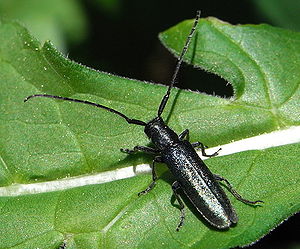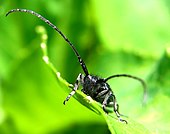Long-haired Scheckhornbock
| Long-haired Scheckhornbock | ||||||||||||
|---|---|---|---|---|---|---|---|---|---|---|---|---|

Long-haired common spotted billybuck Agapanthia intermedia |
||||||||||||
| Systematics | ||||||||||||
|
||||||||||||
| Scientific name | ||||||||||||
| Agapanthia intermedia | ||||||||||||
| ( Ganglbauer , 1884) |
The Long-haired check-horn buck (Agapanthia intermedia) is a beetle of the family of longhorn beetles . It was originally viewed as a variation of the species Agapanthia violacea and thus bore its German name "Langhaariger Scheckhornbock" or "Metallfarbener Distelbock". In the red lists, the name "Long-haired Scheckhornbock" was transferred to Agapanthia intermedia . This takes into account the fact that the hairiness of Agapanthia intermedia is longer than that of Agapanthia violacea .
The genus name Agapanthia (from ancient Greek αγαπάω agapáo, I love and άνθος ánthos, flower) indicates that the species of the genus can often be found on flowers. The genus is represented worldwide with nine subgenera, in Europe with 22 species. The species name intermedia ( Latin ) means "the middle one".
Frieser 1976 and Sama 2002 recorded the variation on the species. A large part of the older find data and further information on Agapanthia violacea therefore relate to Agapanthia intermedia . The two species differ only minimally in their appearance, but through the internal structure (9th tergite ), the appearance of the larvae and the feeding plants, the two species can be safely separated. In addition, the two species have different distribution areas.
Description of the beetle
The metallic blue or green shiny beetle reaches a body length of seven to thirteen millimeters.
The beetle is immediately recognizable as a longhorn beetle by the long antennae, which are longer than the body in both sexes. The forward sloping downwards with the head slightly rearwardly facing mouthparts places it in the subfamily of Lamiinae . The unusual number of twelve antennae links, which are covered with a few longer eyelash hairs on the underside (recognizable in Fig. 2), assign the species to the genus Agapanthia .

|

|
| Fig. 1: from above | Fig. 2: from the front |
| Fig. 3: from the side | |
The metallic body color matches that of Agapanthia violacea . In addition, the antenna elements are not curled in either type. Head and neck shield are finer, the wing covers roughly against and tightly wrinkled punctured . The pronotum is about the same length as it is wide (Fig. 1). In terms of appearance , A. intermedia differs from Agapanthia violacea only in nuances in the hairiness. In A. intermedia, this is provided with a clearly recognizable gray basic hairs towards the end of the elytra (clearly visible in Fig. 3), whereas A. violacea is so finely haired on the entire wing cover that the elytra appear bare to the naked eye. Also in A. intermedia there are usually three white hairy longitudinal lines on the pronotum and the sides of the chest are white hairy.
The larva of Agapanthia intermedia is different from the larva of Agapanthia violacea .
biology
The species loves dry and warm locations and is found on dams, on dry meadows and fields or on sunny forest edges. In contrast to Agapanthia violacea , it is mainly found on widow flowers .
The life cycle is one year. The females lay the eggs on the field scabious and other species of the genus Knautia . The larva eats in the core of the stem. Before pupation, the upper part of the stem is bitten off and a cradle lined with thread-like, cotton-wool-like pegs is placed in the lower part. In the following year, the hatched young beetles drill an oval hole at the side through which they can get outside.
Distribution and occurrence
The reports on Agapanthia violacea from Germany probably all refer to A. intermedia , while in Styria , for example, both species occur in parallel. This probably applies to all of southern and eastern Europe. In north-eastern Europe and Russia, on the other hand, only Agapanthia intermedia is found again . The adults are found in Central Europe from May to August on host plants of the genus Knautia , while A. violacea has a wide range of host plants. In general, the beetle is not common, but localized mass occurrences have also been reported.
literature
- Heinz joy, Karl Wilhelm Harde, Gustav Adolf Lohse (ed.): The beetles of Central Europe . tape 9 . Cerambycidae Chrysomelidae . Spektrum Akademischer Verlag, Munich 1999, ISBN 3-8274-0683-8 (first edition: Goecke & Evers, Krefeld 1966).
- Klaus Koch : The Beetles of Central Europe . Ed .: Heinz Freude . tape 3 : ecology . Goecke & Evers, Krefeld 1992, ISBN 3-87263-042-3 .
Web links
Individual evidence
- ↑ German name in the Red List ( Memento of the original from July 31, 2009 in the Internet Archive ) Info: The archive link has been inserted automatically and has not yet been checked. Please check the original and archive link according to the instructions and then remove this notice. (PDF; 183 kB)
- ↑ Sigmund Schenkling: Explanation of the scientific beetle names (genus)
- ↑ Agapanthia at BioLib
- ↑ Agapanthia at Fauna Europaea. Retrieved February 18, 2013
- ↑ Sigmund Schenkling: Explanation of the scientific beetle names (species)
- ↑ FRIESER, R. (1976): Cerambycidenstudien (Col. Cerambycidae) newsletter of the Bavarian entomologists, 25 (3): 43-44, Munich
- ↑ SAMA G. Atlas of the Cerambycidae of Europe and the Mediterranean Area 1 ... . Èditions Kabourek, Zlín, 173 p.
- ↑ Gianfranco Sama: Notes on the Genus Agapanthia Serville, 1835 (Coleoptera: Cerambycidae: Lamiinae: Agapanthiini) . In: Boletin Sociedad Entomolólgica Aragonesa 42, 2008, pp. 123-127 PDF, 7.3MB
- ↑ E. Reitter: Overview of the metallic-blue and green species of the Coleoptera genus Agapanthia Sv. Wiener Entomologische Zeitung, Volume XIII, Issue 4 (April 20, 1894) as PDF
- ↑ CARRIÈRE J. 2000: Les difficultés de la systematique à l'écobiologie d ' Agapanthia intermedia (Ganglbaur, 1883) pour le département de la Lozère (Coleoptera, Cerambycidae) Lambillionea 100: 432-432
- ↑ English brief information
- ↑ Karl Adlbauer: Addendum to the longhorn beetle fauna of Styria under the aspect of species threat (Coleoptera, Cerambycidae) Joannea Zool 3: 83-104 (2001)
- ^ Distribution and systematics in Fauna Europaea
- ↑ AD.HORION: Faunistics of the Central European Beetles Volume XII p. 190 Überlingen-Bodensee 1974
